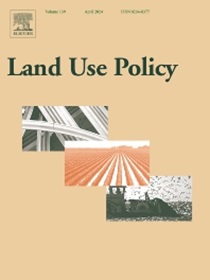土地混合策略:元人口理论对土地节约共享争论的贡献
IF 6
1区 社会学
Q1 ENVIRONMENTAL STUDIES
引用次数: 0
摘要
为了在保持充足农业生产的同时保护生物多样性,提出了两种土地管理策略:土地节约和土地共享。尽管第三种混合战略已经出现,但关于它们效率的争论仍在继续。这些策略之间的平衡依赖于上下文,限制了概括。我们使用基于元种群的模型来模拟不同管理策略下农业景观中的物种持久性。我们的模型捕捉了环境因素的影响,如景观组成、连通性和害虫发生率,使我们能够评估景观管理策略如何影响生物多样性和生态系统服务,如害虫调控。我们的研究结果强调了设计有效景观管理策略的关键因素。首先,在景观范围内保持中等质量的生境(例如农林复合林)对于支持防治虫害,从而提供生态系统服务至关重要。第二,尽管与传统农业相比,农林业的扩张会降低经济回报,但在虫害压力大、生物防治有效的情况下,生物多样性抵消了这些成本。这些发现强调了采用综合方法实施有效的景观管理策略,优化生产力和生物多样性保护的重要性。这项研究揭示了混合“土地混合”战略的潜力,能够超越传统的土地节约共享方法,同时为变化和不确定性提供更大的灵活性。据我们所知,这项研究代表了第一个在不考虑具体环境影响的情况下评估保护策略有效性的理论建模方法。我们的研究结果增强了我们对情境对最佳策略影响的理解,丰富了辩论,并提出了超越错误二分法的新观点。本文章由计算机程序翻译,如有差异,请以英文原文为准。
The land-blending strategy: Contribution of metapopulation theory to the land sparing-sharing debate
Two land management strategies have been proposed to preserve biodiversity while maintaining sufficient agricultural production: land sparing and land sharing. Debate on their efficiency continues, although a third hybrid strategy has emerged. The balance between these strategies is context-dependent, limiting generalizations. We addressed this challenge using a metapopulation-based model to simulate species persistence in agricultural landscapes under different management strategies. Our model captures the influence of contextual factors, such as landscape composition, connectivity, and pest incidence, allowing us to evaluate how landscape management strategies influence biodiversity and ecosystem services such as pest regulation. Our results highlight key factors for designing effective landscape management strategies. First, maintaining intermediate quality habitats (e.g., agroforests) within the landscape is essential to support pest controllers and thus, the provision of ecosystem services. Second, although agroforestry expansion can reduce economic returns compared to conventional agriculture, biodiversity offsets these costs when pest pressure is high and biological control is effective. These findings emphasize the importance of an integrated approach to implement effective landscape management strategies, optimizing both productivity and biodiversity conservation. This study reveals the potential of a hybrid ‘land blending’ strategy, able to outperform traditional land sparing-sharing approaches, while offering greater flexibility for change and uncertainty. To our knowledge, this study represents the first theoretical modelling approach to assess the effectiveness of conservation strategies without considering specific contextual influences. Our findings enhance our understanding of the impact of context on optimal strategies, enriching the debate and suggesting new perspectives beyond its false dichotomy.
求助全文
通过发布文献求助,成功后即可免费获取论文全文。
去求助
来源期刊

Land Use Policy
ENVIRONMENTAL STUDIES-
CiteScore
13.70
自引率
8.50%
发文量
553
期刊介绍:
Land Use Policy is an international and interdisciplinary journal concerned with the social, economic, political, legal, physical and planning aspects of urban and rural land use.
Land Use Policy examines issues in geography, agriculture, forestry, irrigation, environmental conservation, housing, urban development and transport in both developed and developing countries through major refereed articles and shorter viewpoint pieces.
 求助内容:
求助内容: 应助结果提醒方式:
应助结果提醒方式:


